1. Prevalence data and victim surveys
2. Costs of domestic violence
3. Age distribution of domestic violence
4. Number of deaths
1. Prevalence data and victim surveys
Number of occurrences of domestic violence registered by Law enforcement agencies
In 2018, domestic violence (domestic violence), as in previous years, with more than 26 thousand of reported cases, was the second most registered crime in Portugal (the first was theft), corresponding to 8% of all the criminality) and was the most registered crime within the crimes against persons (where represents 33%).
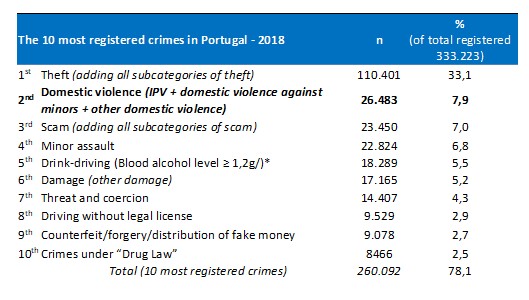
Almost 100% of domestic violence cases are registered by two national law enforcement agencies (LEA) both within the Ministry of Home Affairs (GNR- National Republican Guard and PSP- Public Security Police). Taking into account occurrences registered by these two LEA, in 2018, at national level, the incidence rate was 2,57 cases per 1000 inhabitants. Portugal has 18 districts and 2 autonomous regions (Azores and Madeira). Available data shows differences in terms of incidence rate: Azores and Madeira are the areas with higher incidence rate, following some districts such as Faro, Portalegre, Setúbal and Lisbon.

The number of domestic violence occurrences registered in 2018 reflected a slightly decrease comparing with 2017. Since domestic violence is an autonomous crime in the Penal Code (2007) the number of cases increased until 2010 (when were registered more than thirty-one thousands of cases, following a decrease until 2012. Between 2013 and 2018 the number of cases has remained around the 26 or 27 thousand.
Prevalence data on domestic violence
The numbers previously commented only represent the reported cases to LEA, prevalence data generated by the last survey on violence against women goes back to 2007. Then, approximately 6,1% of women (taking into account the continental part of Portugal) were victims of act(s) within a group of acts of victimization considered (physical, psychological and/or sexual violence), in the last 12 months, in the context of domestic violence (National survey on violence against women and men). The results showed then a decrease in such prevalence rate since the previous survey (in 1995), where such proportion was higher (13,1%).
Statistics Portugal (Public Institute) will implement a new population-based survey on gender violence/domestic violence in the near future (as it is defined in the current National Strategy for Equality and Non-Discrimination). This initiative emerges in the context of a Eurostat’s project.
Homicides in the context of domestic violence
Justice Statistics System provides data regarding the number or persons convicted (courts of 1st instance) by homicide disaggregated by the context (intimate partner violence/ other situations).
As regards homicides where the victim is a spouse or partner it’s observed that since 2010 the number of persons convicted showed a slight decrease (from 38 in 2010 to 20 in 2018) (DGPJ’s press release). The highest value registered (2007-2016) was in 2009 with 44 people convicted. Taking into account the last year available, 2018, 70% of convicted persons in the context of homicide (intimate partner violence) were male and 60% of victims were female (it should be mentioned that in previous years these proportions in terms of men perpetrator and women victims were higher).
In the context of Annual Report of Internal Security (the designated “RASI report” and produced by the Cabinet of the Secretary General of the Internal Security System) some data on homicides from the Judiciary Police (based in the cases under investigation) are provided. In 2018, there were 39 victims of homicide in the context of domestic violence (22 in intimate partner violence context and 17 in the context of other family relations), which represented an increase comparing with the 20 cases in 2017. Among the 39 victims in 2018, 25 were female (RASI report of 2018).
Another source in this area is a Portuguese Non-Governmental Organization – the UMAR (Women’s Union Alternative and Response; União de Mulheres Alternativa e Resposta). UMAR collects data on “femicide”, based in the information available in the news published by the national press regarding female victims of homicide. According with these data, between 2004 and 2019 (until 12th of November), 531 women were victims of homicide, 81% of which in the context of intimate partner violence (IPV) (Sources: UMAR’s report of 2018 and UMAR’s Report of 2019).
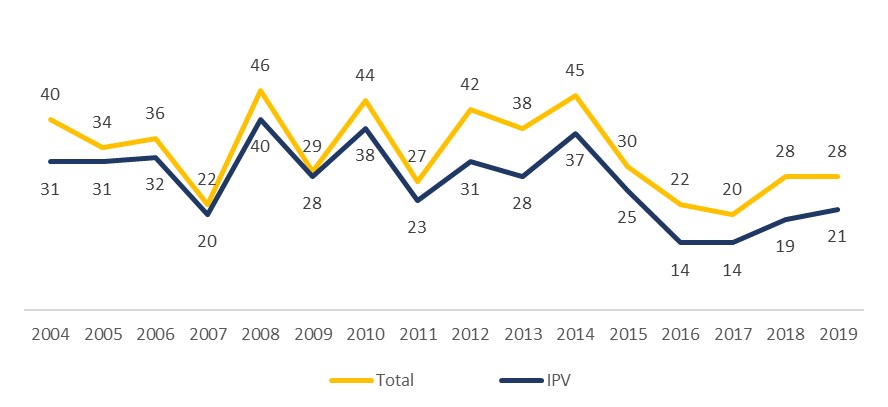
Source: Data from UMAR (NGO)
After a decline of the number of female victims of homicide in general and in the context of intimate partner violence between 2014 until 2016-2017 (from 37 cases of IPV 2014, to 14 cases in 2016 and also in 2017), such value increased again in 2018 and 2019 (19 and 21 women were victims of homicide in the context of intimate partner violence, respectively) (Data from 2019 only covers the period between 1st of January until 12th of November).
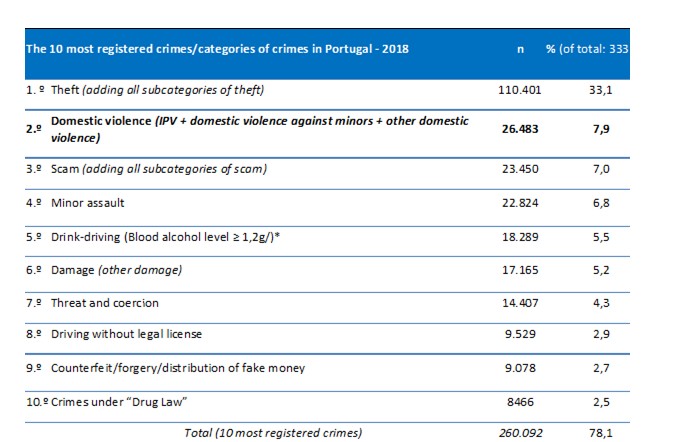
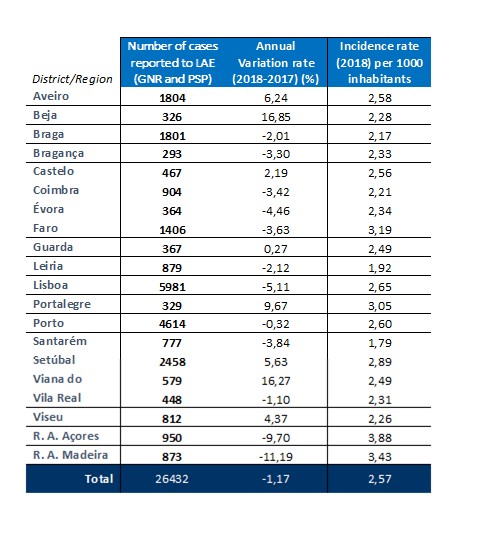
2. Costs of domestic violence
There are two main sources of data on costs of domestic violence and a new procedure to account the domestic violence costs: the EIGE estimates and the Portuguese official sources, the first being global estimates, and the second concrete costs (from organization’s budgets) but incomplete data.
According with data from EIGE (2014), analysed by Duarte et al. (2019), the costs of violence within intimate partnerships are estimated in 2.5 billion euros in 2014. This represents an annual per capita value of 242 euros. Nevertheless, considering the gender violence costs, the value more than duplicate: annual cost reaching 5,4 billion meaning an annual per capita value of 513 euros.
In terms of an organization’s funding example, one can see that the “Rede Nacional de Apoio às Vítimas de Violência Doméstica” (RNAVVD; National Support Network for Domestic Violence Victims) has registered a 42% increase between 2014 and 2017 (see Table below).
| 2014 | 2017 | |
| Victim support structures | 185 329 Euros | 472 000 Euros |
| Shelters | 4 147 243 Euros | 4 766 823 Euros |
| Emergency reception | 307 200 Euros | 1 327 360 Euros |
Source: Prevenção e Combate à Violência contra as Mulheres e à Violência Doméstica (2018), authored by CIG
More recently, and according with the article 80-A of the domestic violence Law each entity from Public Administration should include in the respective budget the expenses for the implementation of this law (all activities and projects related to the violence prevention policy domestic violence or the protection and assistance of its victims). Such expenses are included under the measure 082 (Security and social action – domestic violence – prevention and protection to the victim). For 2020, the total foreseen in this measure in State budget is higher than 20 million Euros.
3. Age distribution of domestic violence
Characterization of victims, perpetrators and occurrences of domestic violence
Characterization of victims (2018)
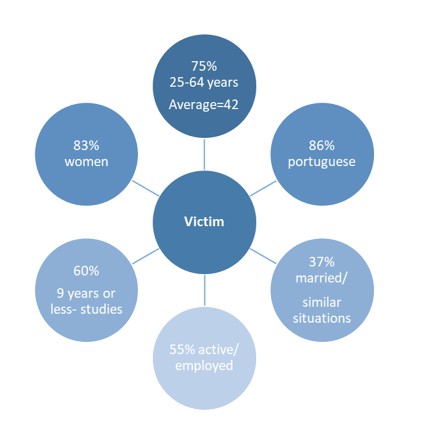
Age of victim and age of perpetrator (2018) (%)
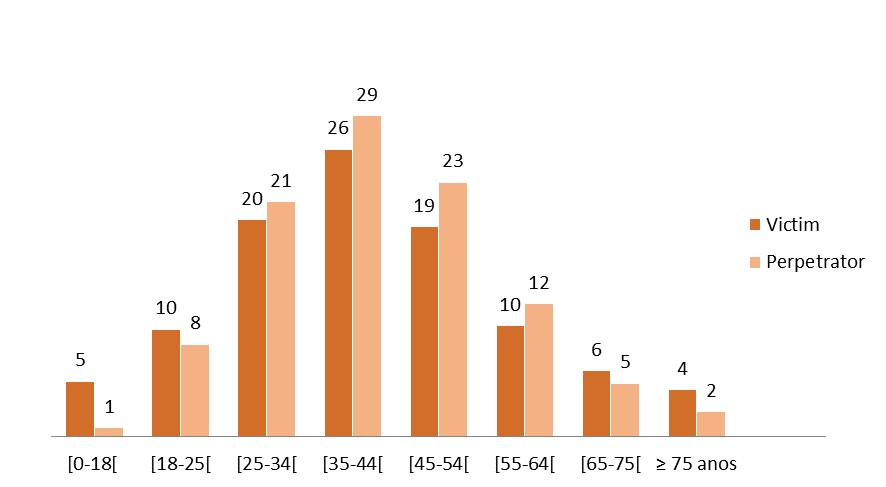
Type of relationship between victim and perpetrator (2018) (%)
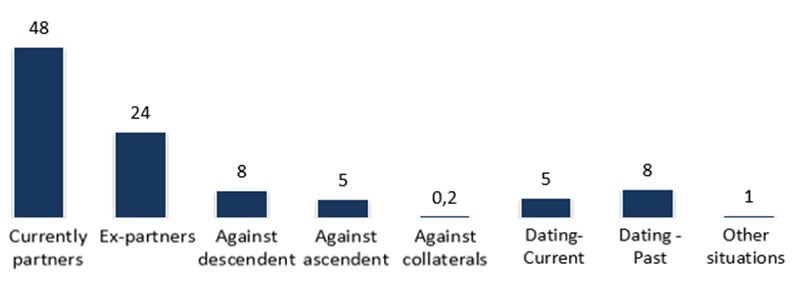
Type of relation and gender: victim-perpetrator 2018 (%)

Characterization of perpetrator (2018)

Characterization of occurrences (2018)
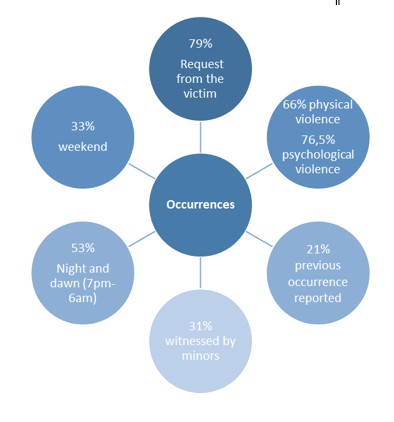
Data regarding final decisions in criminal cases of domestic violence
Last report (from 2018) indicates that among 13588 cases communicated by Prosecution Services to Ministry of Home Affairs (related with decisions from 2018): 79% cases were filed (generally due to lack of evidence: 81%); 16% were charged; and 4% were provisional suspended. Among a total of 1761 final decisions communicated (court level): in 57% there was a conviction and in 43% an absolution; and in 62% of convictions the decision indicates 2 to 3 years of imprisonment (generally suspended).
4. Number of deaths
Homicides in the context of domestic violence
Justice Statistics System provides data regarding the number or persons convicted (courts of 1st instance) by homicide disaggregated by the context (intimate partner violence/ other situations). As regards homicides where the victim is a spouse or partner it’s observed that since 2010 the number of persons convicted showed a slight decrease (from 38 in 2010 to 20 in 2018). The highest value registered (2007-2016) was in 2009 with 44 people convicted. Considering the last year available, 2018, 70% of convicted persons in the context of homicide (intimate partner violence) were male and 60% of victims were female (it should be mentioned that in previous years these proportions in terms of men perpetrator and women victims were higher).
In the context of Annual Report of Internal Security (the designated “RASI report” and produced by the Cabinet of the Secretary General of the Internal Security System) some data on homicides from the Judiciary Police (based in the cases under investigation) are provided. In 2018, there were 39 victims of homicide in the context of domestic violence (22 in IPV context and 17 in the context of other family relations), which represented an increase comparing with the 20 cases in 2017. Among the 39 victims in 2018, 25 were female.
Another source in this area is a Portuguese Non-Governmental Organization – the UMAR (Women’s Union Alternative and Response; União de Mulheres Alternativa e Resposta). UMAR collects data on “femicide”, based in the information available in the news published by the national press regarding female victims of homicide.
According with these data, between 2004 and 2019 (until 12th of November), 531 women were victims of homicide, 81% of which in the context of intimate partner violence (IPV).

Source: Data from UMAR (NGO)
After a decline of the number of female victims of homicide in general and in the context of intimate partner violence between 2014 until 2016-2017 (from 37 cases of IPV 2014, to 14 cases in 2016 and also in 2017), such value increased again in 2018 and 2019 (19 and 21 women were victims of homicide in the context of intimate partner violence, respectively).

